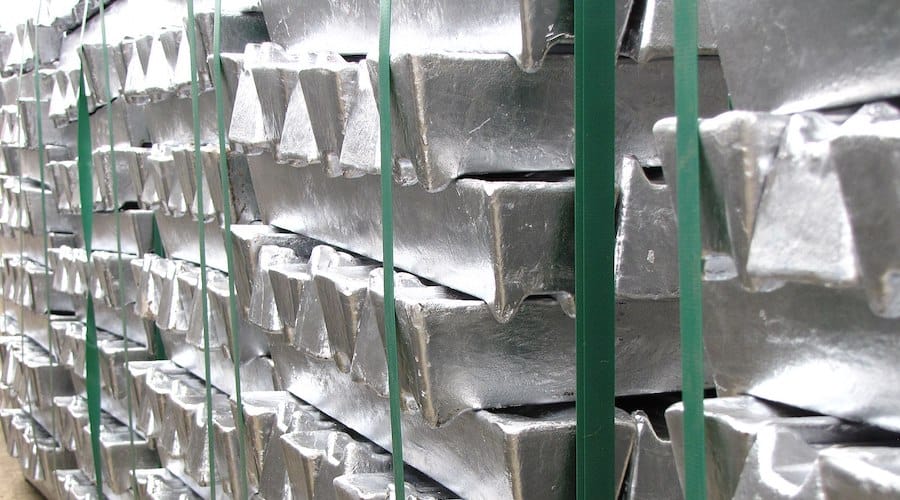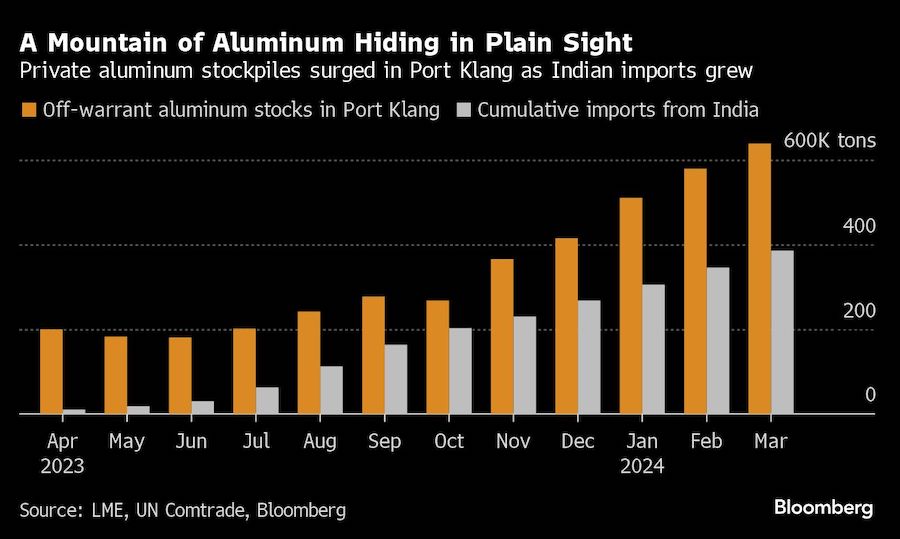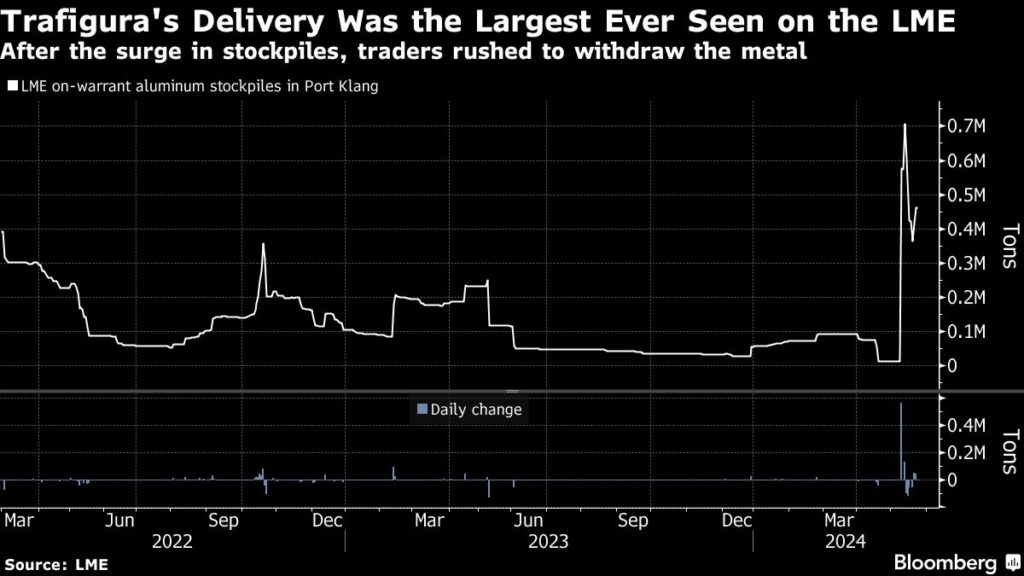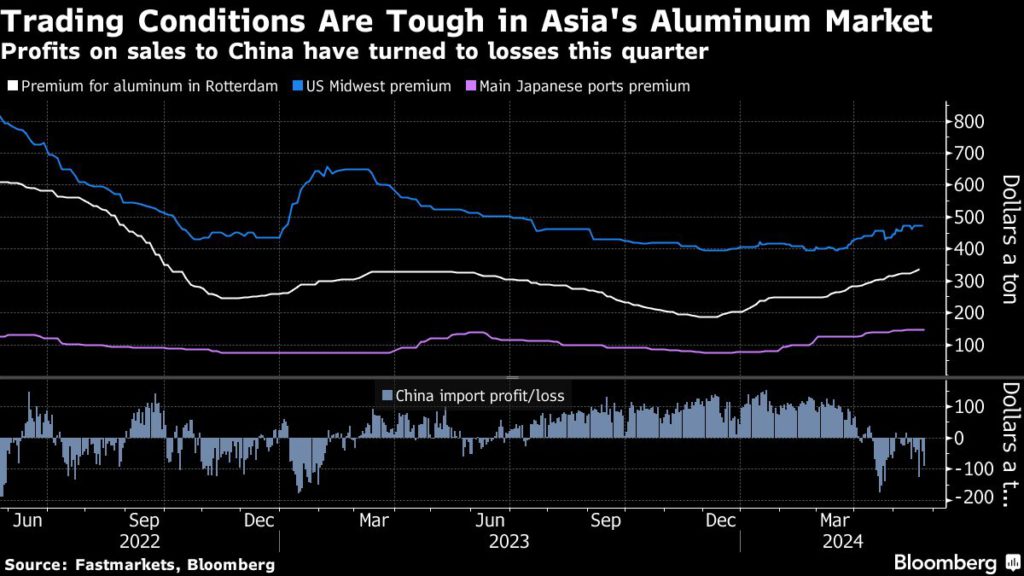
The aluminum market is caught in a clash between some of the biggest traders and banks, with more than $1 billion of metal changing hands while lengthy queues form at London Metal Exchange warehouses.
The result has been a major change in who owns the world’s aluminum inventory, at a time when some are predicting shortages ahead. It’s also heralded a return of the stockpile battles and warehouse queues that have been regular hallmarks of the LME aluminum market, causing controversy among buyers and headaches for the exchange itself. The ballooning backlogs at facilities in Port Klang, Malaysia, mean that traders could now have to wait many months to take delivery of stock.
The events of the past few weeks have been the climax of a trade that began many months ago. Trafigura has been accumulating a stockpile of aluminum in Port Klang over the past year, much of it from India where the trading house has large contracts with suppliers including Vedanta Ltd.
Trafigura’s trade wasn’t a secret: the growing stocks of aluminum in Port Klang — a key global hub for aluminum storage — were visible in the LME’s monthly reports on metal stored outside its network of warehouses.
But nobody in the wider aluminum market knew exactly what Trafigura would do with the metal. Often, traders accumulating large stashes see opportunities to profit from increases in the physical premium that buyers pay over and above the LME price. If demand outstrips supply, the location-specific premiums tend to rise as real-world consumers of aluminum draw down metal that’s held in stockpiles.

Instead, in the past two weeks, about 650,000 tons of aluminum sitting in Port Klang was suddenly transferred onto LME warrant. Trafigura was the key player behind the deliveries, which led to an increase in live warrants of more than 500,000 tons on May 10 — the largest single-day delivery onto the LME in at least 27 years.
A few days after the deliveries began, Trafigura laid out its bearish outlook at a conference in London. Analyst Henry Van predicted that aluminum prices would fall, saying it was seeing “a very grim demand picture right now,” and noting recent smelter restarts.
But other traders are taking the opposite view. Of the metal delivered to LME warrant in the past two weeks, about 400,000 tons — worth about $1 billion at current prices — was quickly requested for delivery out again. The buyers include hedge fund Squarepoint, and banks like Citi and JPMorgan, the people said.
In the short term, the buyers of the aluminum in Port Klang are likely to use it for so-called financing deals — holding physical aluminum and selling higher-priced futures. But in the longer term, the biggest payoff for the trade would come if the physical market tightens to a level that allows it to be shipped to real-world buyers for a profit.
The bullish view of aluminum has a growing following: investors on the LME, who were collectively short aluminum as recently as mid-March, have lifted their bets to the most bullish level in two years.
Inventories remain relatively low, while production in China is nearing a 45 million-ton-per-year cap imposed by Beijing. Add in forecasts for demand growth of 3.1% this year — led by demand from China and India — and the market is set to tighten in the second half of this year, according to CRU Group.
“We’ve come to the end, largely, of destocking cycles in various sectors,” said Ross Strachan, principal analyst for aluminum at CRU. “As demand picks up, the industry will need to encourage the restart of new capacity.”

The metals world has a long history of traders battling over giant stocks of aluminum, which can generate hundreds of millions of dollars a year in storage and handling fees. Just last month, Trafigura and rival Glencore Plc grabbed the market’s attention with a trade made possible by new sanctions imposed on Russian metal, involving ordering out and re-delivering large volumes of aluminum. (The LME responded by rushing out new rules to undermine the traders’ antics.)
But the decision to offload the mountain of stock onto the LME has puzzled many of Trafigura’s competitors in the aluminum market, and the scramble to get hold of it has underscored its value to rival traders. Facing soft trading conditions in the physical market, Trafigura may have taken the view that the quickest and most lucrative way to turn a profit on the metal would be to sell it on the LME and collect a share of the rent from future owners.
Traders delivering large volumes to the LME generally enter “rent share” deals with the warehouse company they’re delivering to, meaning they earn a share of the revenues for as long as the metal stays in the warehouse. At a rent of 56 cents a day, the total rent on 650,000 tons of aluminum could be worth as much as $133 million a year — more than $200 a ton — as long as it stays where it is.

If it’s all requested for delivery, the total earnings would be a fraction of that amount. Still, it is guaranteed to earn a certain amount of money — about $40 a ton in rent — because the metal is only delivered out at a rate of a few thousand tons a day.
The big orders for the withdrawal of aluminum have already led to a long queue to take delivery from warehouses in Port Klang operated by Istim Metals. The LME has rules to limit rents as soon as warehouse queues exceed a certain threshold, which it introduced after spiralling backlogs for aluminum drew consumer ire and regulatory scrutiny a decade ago.
Representatives for Trafigura, Squarepoint, Citi, JPMorgan and Istim all declined to comment. The LME has said its rules are designed to “disincentivize the build-up of queues.”
So far, the bulls have held the upper hand. Aluminum prices on the LME have risen about 4% since Trafigura’s deliveries began, hitting a 23-month high on Tuesday after Rio Tinto Group declared force majeure on some alumina supplies from Australia.
And physical premiums have been rising since the start of the year, particularly in Europe, where output was slashed when energy prices spiked in 2022 and where Russian tons that previously supplied the continent have been redirected to Asia.
Still, the long queue in Port Klang already appears to have deterred some would-be buyers: of the 400,000 tons requested for delivery in the past two weeks, about 60,000 tons of those requests were subsequently retracted.
